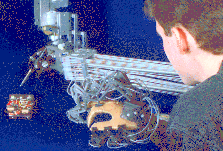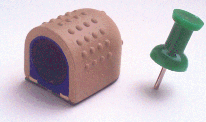Grasping and Master Gloves

This project is generally concerned with both autonomous control
and teleoperation of the Utah/MIT Dextrous Hand. Current hardware
includes a right hand, a 6-DOF Cartesian robot table, and a Utah
Dextrous Hand Master.
Fingertip Force Control
Actual demonstrations of robot grasping are far behind theories of
grasp control, and what is needed is to implement even the simplest
schemes well rather than develop yet more unimplementable theories.
The approach has been to characterize the hand's drive system, in
order to understand mechanical limitations in finger control and to
improve performance insofar as possible by model-based low-level
control.
- The actuators, comprised of electropneumatic servovalves and
pistons, were modeled and identified experimentally, and a model-based
controller was developed (Henri and Hollerach, 1994).
- The dynamics of the tendon drive system was experimentally
characterized (Nahvi and Hollerbach, 1994).
- Feedback and feedforward control schemes were developed and
contrasted for actuator, tendon, and fingertip force control (Nahvi,
M.Eng. thesis, Dec. 1994).
Based on these studies, it has been determined that tactile
sensors are required for accurate fingertip force control. We plan to
incorporate capacitance-based tactile sensors developed by Sarcos for
this hand. Finally, we are hoping to obtain a left hand to study
two-handed manipulation, since the utility of using just one hand is
limiting.
Task-Oriented Sensor-Based Manipulation
This project concerns the development of advanced sensing systems
combined with sensor based processing, planning and control strategies
for autonomous robotic manipulation, inspection and assembly tasks.
One aspect is to develop an instrumented gripper for the Sarcos
Dextrous Arm, that incorporates proximity sensing and tactile sensing.
The tactile sensors are being developed in conjunction with Sarcos,
which has developed capacitance-based tactile sensors for the Utah/MIT
Dextrous Hand (Johnston, Zhang, Hollerbach, and Jacobsen, "A full tactile sensing suite for dextrous robot
hands and use in contact force control," Proc. IEEE
Intl. Conf. Robotics and Automation, Minneapolis, April 22-28,
1996, in press.)

Teleoperation with Master Gloves
The Utah Dextrous Hand Master, a prototype exoskeleton-based
position master, is used to measure finger joint angles. This hand
master is the most accurate one available, because of the use of
four-bar linkages. The hand master has been used to control the
Utah/MIT Dextrous Hand, while the Bird magnetic sensor (Ascension
Technology) controls the position and orientation of the Cartesian
robot holding the hand.
In order to achieve a high level of performance in this teleoperation,
three problems were identified and addressed.
- Kinematic mismatch between the human hand and robot hand. A
Cartesian fingertip mapping algorithm was developed to circumvent this
mismatch (Rohling, Hollerbach, and Jacobsen, 1993). Key features over
past approaches include handling workspace boundaries explicitly,
mapping orientation as well as position, and a three-level priority
scheme if the desired human fingertip position and orientation is not
exactly realizable.
- Inaccurate kinematic model of the human hand. An open-loop
calibration method was applied to obtain an accurate kinematic model
of a human operator's hand (Rohling and Hollerbach, 1993, 1994). This
approach is much more accurate than past schemes which relied on
caliphers and bony landmarks. The 1994 IEEE International Conference
on Robotics and Automation version of the paper received the Anton
Phillips Best Student Paper Award.
- Control errors by the robot hand in following the commanded
trajectory. This aspect has been addressed in the fingertip control
studies above.
The robot hand is presently attached to a three degree-of-freedom
Cartesian robot table, with a 3-roll wrist based on Rosheim's simple
hollow wrist. The two parts of this robot were products of different
design projects involving students at McGill University. In the
longer run, we wish to develop force reflection and tactile
stimulation in a hand master.


